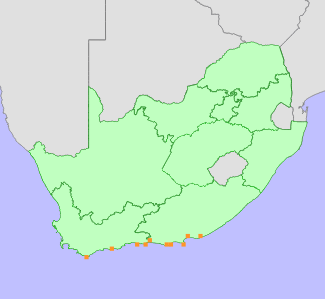|
Scientific Name | Hyobanche robusta Schönland |
Higher Classification | Dicotyledons |
Family | OROBANCHACEAE |
National Status |
Status and Criteria | Endangered B2ab(ii,iii,v) |
Assessment Date | 2022/10/05 |
Assessor(s) | A.D. Wolfe & D. Raimondo |
Justification | This localized habitat specialist with a narrow distribution range has an extent of occurrence (EOO) of 13 245 km² and an area of occupancy (AOO) of 96 km². It is declining due to ongoing habitat loss and degradation across most of its range, but it is still fairly common. The remaining subpopulations are severely fragmented, each with fewer than 250 mature individuals. This species requires periodic disturbance of its dune habitat for recruitment, and both development and invasive plants lead to the stabilization of dune systems. Therefore, it is listed as Endangered under criterion B. |
Distribution |
Endemism | South African endemic |
Provincial distribution | Eastern Cape, Western Cape |
Range | This species has a narrow distribution along the coastline of Eastern and Western Cape Provinces, from Kenton On Sea to Struisbaai. |
Habitat and Ecology |
Major system | Terrestrial |
Major habitats | St Francis Dune Thicket, Goukamma Dune Thicket |
Description | It occurs in deep sand dune systems. |
Threats |
| The main threat to this species is habitat loss and degradation resulting from coastal developments, which are mostly historical across the species' range in the Eastern Cape. Due to the degradation and transformation of the coast, many dune systems have become very fragile, and it appears that the dunes have been planted to prevent erosion. This may not be a suitable plan for H. robusta (A. Wolfe, pers. obs.).
Furthermore, alien invasive species pose a threat. |
Population |
Although habitats have been degraded and lost, H. robusta persists along the Eastern Cape coast. Despite the fragmentation of the population due to habitat loss and degradation, subpopulations often comprise small numbers (less than 250 mature individuals). A continuing decline is inferred from ongoing habitat loss and degradation.
|
Population trend | Decreasing |
Assessment History |
Taxon assessed |
Status and Criteria |
Citation/Red List version | | Hyobanche robusta Schönland | EN B1ab(ii,iii,v) | Raimondo et al. (2009) | |
Bibliography |
Dreher, H., Rodgerson, C. and Young, A. 2014. A new combination and the description of a new species in the section Avonia of the genus Anacampseros (Anacampserotaceae). Bradleya 32:105-111.
Raimondo, D., von Staden, L., Foden, W., Victor, J.E., Helme, N.A., Turner, R.C., Kamundi, D.A. and Manyama, P.A. 2009. Red List of South African Plants. Strelitzia 25. South African National Biodiversity Institute, Pretoria.
|
Citation |
| Wolfe, A.D. & Raimondo, D. 2022. Hyobanche robusta Schönland. National Assessment: Red List of South African Plants version 2024.1. Accessed on 2025/12/08 |
 Comment on this assessment
Comment on this assessment


